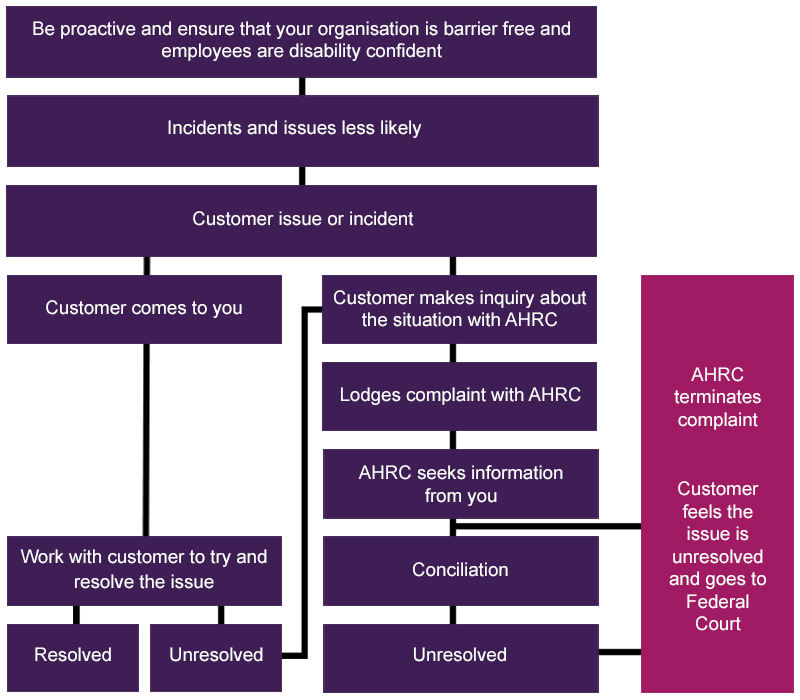What are your responsibilities?
Dealing with issues
When a customer feels that they have a disability discrimination complaint against a business they can make a complaint in writing to the Australian Human Rights Commission (AHRC) who will also assist with documenting and translating the complaint if required. People do not require a lawyer to do this and it is free.
If the AHRC decides to investigate further, they will contact the organisation, provide details of the complaint, and potentially ask for comments and more information to understand the issue. They then decide if the complaint has some basis for complaint and probably seek to conciliate a solution between the customer and the organisation. This process happens in a variety of different ways including face-to-face, over-the-phone and sometimes through an exchange of information.
If the complaint is not resolved, or is discontinued by the AHRC, then the customer has 60 days to take the complaint to the Federal Court of Australia. The customer needs to do this for themselves and seek the assistance of a lawyer. There are several organisations that represent customers with these types of complaints.
The following flowchart helps to outline the process and responsibilities:

The following cases, which relate mostly to retail environments, are drawn from the Australian Human Rights Commission's conciliation register*Developed from https://www.humanrights.gov.au/complaints/conciliation-register
Viewed September 2016. The AHRC administers the Disability Discrimination Act 1992 Cth and can conciliate between parties on cases of discrimination.
- 2015, a customer that uses a wheelchair complained to a restaurant that the accessible toilet had no lock on the door. The restaurant said that the door was built to regulations and that no-one has previously complained. The AHRC conciliated between the two parties and the restaurant installed a lock on the door and offered a meal voucher.
- 2015, a dentist refused to allow an assistance animal to remain in the waiting room claiming he was afraid of dogs. The AHRC conciliated between the two parties and the dentist wrote and apologised to the client.
- 2015, a person who was a wheelchair user claimed that a hotel was not fully accessible and did not have an accessible toilet. The hotel worked through conciliation and provided accessible toilet facilities and permanent ramps.
- 2015, a customer of a telecommunications company who was blind and therefore did not drive was required to provide a driver's licence (and refused alternative photo identification) to buy one of its products. The company agreed to pay the customer $3,000 and outlined its policies and procedures and staff training on discrimination.
- 2014, a customer of a medical practice with physical disability who used a motor powered wheelchair claimed that the medical practice refused to let him in because of the size of the wheelchair. They were concerned that it posed a risk because of its size, but during conciliation the customer demonstrated that they could safely manoeuver and they agreed to allow him to use it in the future.
- 2014, a customer in a shopping centre used an assistance animal used to alleviate the effects of bipolar disorder and social anxiety. The security guard refused her access because she was not ‘blind’ despite being shown identification information about the dog. Through conciliation the shopping centre and security company assured the customer that they would be welcomed with their dog in future and provided training for their staff.
- 2014, a customer was refused access to a bread shop with their guide dog. The staff told the customer that health regulations prevented this. The shop's owner agreed to conciliation and apologised to the customer. Staff training was provided and a donation made to a charity.
- 2012, a person who was vision impaired complained that a shopping centre was difficult to access because there were no TGSIs or handrails. Through conciliation the shopping centre agreed to carry out work to make the shopping centre more accessible to people with vision impairment.
- 2012, a customer of a bank complained that a step at the front entrance of his local bank branch prevented him from using it. He had used walking sticks to assist him to walk. The bank installed a handrail to assist him to use the branch and resolved the person's complaint.
- 2012, a customer of a bank that used a mobility scooter had been served by bank staff outside the branch doors because the scooter was too large to manoeuvre on the landing. When the bank stopped this arrangement due to the risks to staff handling money outside the premises, the customer complained. The bank agreed to make modifications to the landing area so the customer could access the branch.




